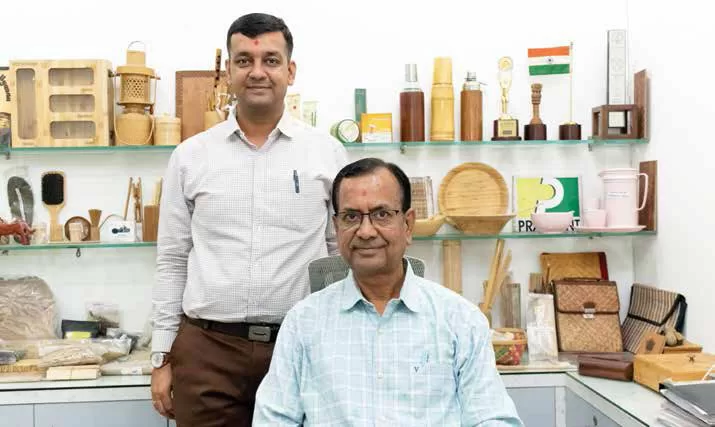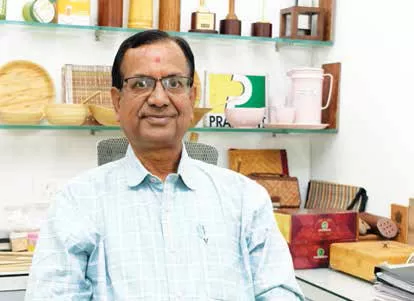
Prashant Bamboo Machine: A Leading Name in Bamboo Processing
The agarbatti industry’s reliance on China andVietnam for raw materials is declining as domesticproduction gains momentum under the Make inIndia initiative. Nagpur-based Prashant BambooMachinery Private Limited is playing a key role inthis shift by manufacturing machines that produceessential raw materials such as bamboo sticks andpowder. The company, established in 1999, suppliesmachinery to firms that provide these materials toagarbatti manufacturers. Speaking exclusively toSugandh India, Ved Prakash Soni, the company’shead, highlighted how domestic production isstrengthening. Till some years ago, China wasthe major source of bamboo sticks for domesticagarbatti manufacturers: Today, bamboo producedlocally compensates for the bulk of the demand.Furthermore, the nation exports bamboo stickmanufacturing machines to countries such as SouthAfrica and Vietnam. Mr Soni also emphasised thatIndian-manufactured bamboo sticks offer superiorquality to Chinese imports while remainingcompetitively priced. He explained that domesticproduction benefits from lower transportation costsand faster supply chains, making it a more viableand sustainable alternative to Chinese imports.

Bamboo sticks remain a critical raw material in theagarbatti industry, with demand shifting towardshigher-quality production. Ved Prakash Soni,head of Prashant Babu Machinery Private Limited,highlighted how the industry has evolved from handcrafted,square-shaped bamboo sticks with visible fibres to theincreasing preference for smooth, round sticks. Thisshift has driven the development of advanced machinery,enabling many Indian companies to manufacture bamboosticks domestically. Since 2006, India has been producingboth square and round bamboo sticks. Previously, theindustry relied heavily on imports from China, but domesticproduction is now rapidly expanding across multipleregions, supported by government initiatives and enhancedtechnical expertise. The demand for bamboo stick-makingmachines has surged, according to Mr Soni. Most largeagarbatti manufacturers get bamboo sticks outsourced.
He noted that earlier, Indian manufacturers struggled with quality due to the lack of high-grade raw materials, but this issue has largely been resolved. Automation requires specialised techniques. The processing of bamboo plays a crucial role in improving output quality. Mr Soni pointed out that India now has access to premium bamboo varieties,such as Tulda bamboo from Assam, among others, making high-quality production more feasible.
Bamboo stick manufacturing involves a detailed, multi-step process that ensures high-quality production for the agarbatti industry. Ved Prakash Soni, head of Prashant BabuMachinery Private Limited, explained that the process begins with splitting bamboo into six, eight, or ten sections.
The material is then cut to size, with knots removed and slides prepared. To produce 1.3mm sticks, manufacturers use 2mm slides, which are then processed into smooth,round sticks of 8, 9, or 12 inches. A specialised polishing machine ensures a refined finish, as agarbatti production requires exceptionally smooth bamboo material. The manufacturing process also generates by products that contribute to other industries. Bamboo dust, a key residue,is used as a raw material in agarbatti manufacturing, while small bamboo pieces and knots are burned to produce charcoal, which has various industrial applications.
Mr. Soni highlighted the importance of a complete machinery setup for bamboo stick production, adding that their company provides comprehensive solutions to stream line operations. Besides manufacturing agarbattis, bamboo is used in various industries, including furniture, house holddecor, toothpicks, toothbrushes, fabrics, and kitchenware.
Mr Soni expects bamboo usage to rise significantly,particularly as industries seek alternatives to plastic in response to climate change concerns. The government encourages bamboo cultivation, recognising its potential as a sustainable resource. Bamboo trees mature within two to three years, offering significant economic benefits to farmers while supporting the shift toward eco-friendly manufacturing.
The fibre-based bamboo, behaves differently from wood when processed, making it ideal for manufacturing bamboo sticks and other products. Mr Soni explained that when split, bamboo produces continuous strips, unlikewood, which does not exhibit the same characteristics.
He highlighted that the basic machinery setup for bamboo stick production costs approximately ₹7 to ₹8lakh. This setup includes machines for bamboo cutting,manual splitting, slicing, sizing, rounding, and polishing.
Additional machines can be integrated later to enhance production and improve quality. With high-quality bamboo, manufacturers can also produce longer sticks,increasing efficiency. For a more advanced production facility, an investment of around ₹10 to ₹11 lakh is required.
This setup empowers the production of a wider range ofbamboo-based products, including toothpicks, agarbatti sticks, bamboo brooms, earbuds, and spoons. Soni also pointed out that major agarbatti manufacturers typically donot purchase machinery directly. Instead, companies that supply bamboo sticks to these manufacturers invest in the equipment. Discussing market expansion, he noted that their machines are now installed across multiple regions,including Maharashtra, Assam, and Tripura, indicating growing demand for domestic bamboo processing solutions.
The agarbatti and bamboo industries operate as distinct sectors, with bamboo sticks serving as a raw material for agarbatti production while catering to multiple other industries. Mr Soni emphasised that Indian manufacturers are increasingly shifting away from reliance on Chinese imports due to cost advantages and supply chain concerns.
Comparing pricing and logistics, he noted that Indian bamboo sticks are more cost-effective than their Chinese counterparts.Importing from China requires businesses to place orders at least two months in advance, leading to potential delays and logistical challenges. Additionally, trade uncertainties between India and China have raised concerns among major business owners regarding supply security. As a result, both the government and entrepreneurs are actively developed in domestic alternatives to ensure a stable supply chain.
Regardless of faith,people will persist in worship, shop owners will light an incense stick everyday, reinforcing the industry’s long-term viability. Given these factors, he predicted consistent growth and stability in the agarbatti sector.
Looking ahead, Soni revealed that his company is working on solar-powered machines to facilitate bamboo stick production in rural areas. At present, their machines operate on three-phase electricity, but they are developings maller, single-phase machines to support installations in remote locations where bamboo is naturally available.
Establishing production facilities in villages and small towns will help streamline manufacturing, reduce transportation costs, and lower labour expenses. He pointed out that labour costs have become a significant factor in all industries, and decentralising production will help control raw material expenses.
By implementing such measures, the industry can further reduce reliance on Chinese imports while strengthening India’s self-sufficiency in bamboo-based manufacturing.
The Agarbatti Association should collaborate under the Make in India initiative to leverage the rapid advancements in the bamboo sector, according to Mr Soni. He highlighted that the government is actively developing bamboo clusters, urging agarbatti manufacturers to engage in these initiatives for collective growth.
Explaining the cluster model— Soni stated that it focus eson regional industrial development. Hecited Nagpur as an example, where anagarbatti cluster has already generated significant employment opportunities.The government supports such clusters by offering businesses subsidised land and easy access to loans, providing a strong foundation for expansion. Here commended integrating bamboo stick production with agarbatti clusters to create a mutually beneficial ecosystem.
Recognising this synergy, the government has taken steps to improve the quality, pricing, production,and availability of bamboo sticks. Discussing the future of the agarbatti industry, Soni expressed confidence in its sustained demand. He explained that spiritual and religious practices will continue, ensuring a steady market for agarbattis. Regardless of faith, people will persist in worship, shop owners will light an incense stick everyday,reinforcing the industry’s long-term viability. Given these factors, he predicted consistent growth and stability in the agarbatti sector.



